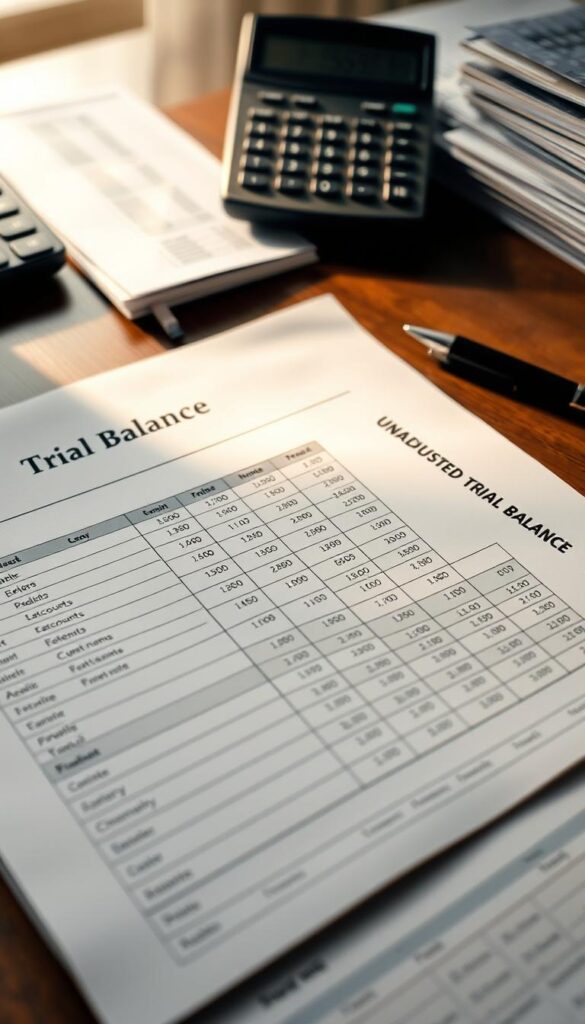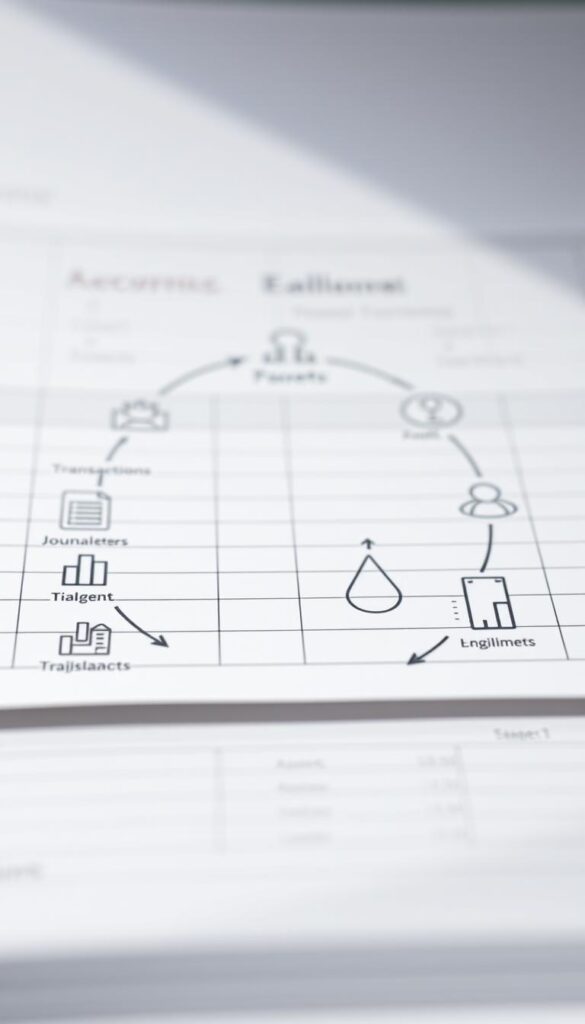Ever wondered how financial transactions turn into detailed financial statements? Knowing the accounting cycle is key for those in finance or accounting. This process organizes business activities and shows your financial health accurately. We’ll explore each step of the accounting cycle, from starting with transactions to making key financial statements like the income statement and balance sheet. Let’s dive into the details of this important accounting process.
Key Takeaways
- The accounting cycle has nine steps that turn business activities into financial statements.
- Double-entry bookkeeping keeps things balanced by making sure debits and credits add up.
- The unadjusted trial balance checks if debits and credits are equal before adjusting entries are made.
- Adjusting entries fix mistakes and make sure financial records match real conditions.
- The accounting cycle goes on all the time, usually for a month, quarter, or year.
- Managing the accounting cycle well is key to tracking your financial health accurately.
- Using automated accounting systems can cut down on errors, improving your financial work.
Understanding the Accounting Cycle: An Overview
The accounting cycle is a key process for keeping financial reports accurate. It has eight main steps that help businesses track and analyze their money dealings. These steps make sure companies follow rules and show their financial data clearly.
Defining the Accounting Cycle
The cycle begins with finding transactions and ends with closing the books after making financial statements. It covers a set period, usually a year. Each step helps understand a company’s money activities. Using the cycle helps keep records balanced and shows the value of accounting for making decisions.
Importance in Financial Reporting
Accounting is very important. It helps make financial reports that investors and regulators can trust. The accounting cycle gives a clear way to track money dealings and make financial statements believable. By following this cycle, companies can make their reports on time and meet legal requirements.
| Step | Description |
|---|---|
| 1. Transaction Identification | Recognizing and documenting financial transactions. |
| 2. Journal Entries | Recording all transactions using the double-entry method. |
| 3. Posting to General Ledger | Transferring journal entries to the general ledger for organization. |
| 4. Trial Balance | Ensuring that total debits equal total credits. |
| 5. Adjusting Entries | Making necessary adjustments for accruals and deferrals. |
| 6. Adjusted Trial Balance | Calculating balances after adjustments to verify accuracy. |
| 7. Financial Statements Preparation | Preparing balance sheet, income statement, and cash flow statement. |
| 8. Closing the Books | Resetting income and expense accounts for the next cycle. |
Identifying Transactions: The Starting Point
Every accounting cycle starts with finding all the transactions in a certain time frame. This is key to making sure all money matters are well recorded and handled. Different kinds of transactions, like sales and expenses, help paint a complete picture of a company’s finances.
Types of Accounting Transactions
There are several kinds of accounting transactions. These include:
- Sales transactions, where goods or services are sold.
- Expense transactions, showing the costs of running the business.
- Inventory changes, noting when stock levels go up or down.
- Debt transactions, like loans or other debts the business takes on.
The Role of Recordkeeping
Good recordkeeping is at the heart of accounting. It’s what keeps all financial activities running smoothly. Every transaction needs to be documented well to keep financial data accurate.
Keeping good records has many benefits. It helps in making accurate financial reports and analysis. It also ensures the business follows the law and makes it easier for audits.
By keeping everything organized, businesses can track and report their finances better. This makes the accounting process more efficient and trustworthy.

Recording Transactions in Journals
Identifying transactions is the first step in the accounting cycle. Then, making journal entries is key. Each entry records important details about the financial activity. This follows the double-entry accounting principle, which ensures that every transaction affects at least two accounts.
Creating Journal Entries
Making journal entries needs careful attention. Each entry includes the date, amounts, affected accounts, and a brief description. For example, a cash journal entry for a $600 payment from a client would debit the cash account by $600 and credit accounts receivable by $600.
When buying office supplies for $100, the cash account is credited by $100, and the expense account is debited by $100. These examples show how important it is to record financial activities accurately.
Accrual vs. Cash Accounting
The choice between accrual and cash accounting affects when journal entries are made. Accrual accounting records events when they happen, not when cash is exchanged. For instance, monthly adjusting journal entries are needed to match expenses with revenues for each period.
Cash accounting, on the other hand, records transactions only when cash is exchanged. A $1,000 loan payment might be split into $800 for the principal and $200 for interest. This shows how accrual accounting can have more detailed journal entries.
| Method | Recognition of Revenue | Recognition of Expenses | Example of Journal Entry |
|---|---|---|---|
| Accrual Accounting | When earned | When incurred | Receiving a $1,000 invoice: Debit A/R $1,000, Credit Revenue $1,000 |
| Cash Accounting | When cash is received | When cash is paid | Payment of $600 cash: Debit Cash $600, Credit Service Revenue $600 |
Posting to the General Ledger
After you create journal entries, the next step is to post transactions to the general ledger. This step connects recorded transactions to financial statements. The general ledger is the main place for all financial activities, sorted by account type like assets or revenue. It’s key to understand its structure and keep financial accounts accurate for good financial management.
The Structure of the General Ledger
The general ledger holds all account ledgers in a business, usually in a three-column format. It has columns for debits, credits, and balances, plus item descriptions for clarity. Every transaction must follow the accounting equation, so debits equal credits. This balance helps find mistakes, like posting to the wrong account.
| Account Type | Debits | Credits |
|---|---|---|
| Assets | Increase | Decrease |
| Liabilities | Decrease | Increase |
| Equity | Decrease | Increase |
| Revenue | Decrease | Increase |
| Expenses | Increase | Decrease |
For instance, posting a journal entry for $1,500 rent involves debiting Expense and crediting Cash with the same amount.
Maintaining Accurate Financial Accounts
Keeping the general ledger up to date is critical to avoid penalties and ensure accurate records. By posting transactions and running trial balances, you can spot errors from invoicing or billing. This effort helps in making accurate financial reports and tax filings.

The Unadjusted Trial Balance: Ensuring Accuracy
The unadjusted trial balance is key in accounting, made at the end of an accounting period. It checks if total debits match total credits, a basic rule of double-entry accounting. This balance shows if transactions were recorded right and helps find errors before making financial statements.
Definition of a Trial Balance
A trial balance lists all financial balances in the general ledger. At the end of an accounting period, an unadjusted trial balance is made. It checks if debit balances equal credit balances. For example, if totals are $152,000 in both columns, it means entries were recorded correctly.
Importance of Debits and Credits Matching
Matching debits and credits is very important. Checking the unadjusted trial balance often finds errors. It uses a spreadsheet with columns for account name, debit, and credit. This makes it clear and helps keep financial records accurate.
Automation tools can also help by cutting down on mistakes. This makes the process more efficient.

The Accounting Cycle Explained: From Transactions to Financial Statements
The accounting cycle is a process that businesses use to track their money. It helps turn transactions into useful financial reports. This journey starts with recording each transaction and ends with reports that show how well the company is doing financially.
This method makes sure all data follows accounting rules. It helps in making smart decisions for the company.
The Transition from Transactions to Reports
The cycle starts with recording transactions. These are then organized and turned into reliable data. You go through steps like posting to ledgers and checking information with trial balances.
This process leads to making financial statements. These statements show the company’s financial health. They help keep track of money and follow accounting rules.
Key Financial Statements Overview
Three main financial statements come from the accounting cycle. They are the income statement, balance sheet, and cash flow statement. Each has its own role:
- Income Statement: This shows how much money the company made and spent, over a certain time.
- Balance Sheet: It gives a picture of what the company owns, owes, and its value at a specific time.
- Cash Flow Statement: This tracks the money coming in and going out, showing if the company has enough cash.
These reports are key to understanding how well a company is doing. With the accounting cycle explained, you can handle financial management and planning better.

The Significance of Closing the Books
Closing the books is a key moment in the accounting cycle. It happens at the end of each financial period, like monthly, quarterly, or yearly. This process makes sure financial reports are accurate and reliable, which is vital for good financial analysis.
Understanding the Closing Process
The closing process wraps up all financial dealings for the period. It includes making adjustments and getting ready for the next cycle. About 60% of businesses close their books monthly. This helps them keep a close eye on their finances and meet tax rules.
At the end of the year, checking accounts and balancing them is very important. It takes up to 30% of an accounting team’s time. Sadly, 40% of accountants say they’re often short on time. This can lead to stress and mistakes, affecting up to 20% of financial reports.

Impacts on Financial Analysis
Closing the books greatly affects financial analysis. It lets companies check how well they’re doing. Automated systems can cut closing time by 25%, making tasks easier. About 70% of small to medium-sized businesses use software like QuickBooks and Xero.
Having a clear closing schedule can improve efficiency by 30%. Good communication can reduce mistakes by 15%. Training staff well can cut errors by 20%, showing how important it is to follow procedures.
Keeping detailed records of debits and credits is key. This ensures financial statements are accurate. Closing the books not only ends a reporting period but also prepares for future analysis. It gives reliable data for planning and making smart decisions.
Compliance and GAAP in Financial Reporting
Keeping up with GAAP standards is key for U.S. businesses. These rules make sure financial reports are clear and easy to compare. By following these rules, companies meet legal needs and gain trust from investors and regulators.
Importance of GAAP Standards
GAAP is vital for companies listed on stock exchanges. It’s also a must for government bodies in all 50 states. With 77% of S&P 500 companies using adjusted earnings, sticking to GAAP is more important than ever.
Benefits of Adhering to Accounting Principles
Companies that follow GAAP gain many benefits:
- Improved Transparency: Trust grows among investors and customers.
- Regulatory Confidence: Avoiding legal trouble is easier.
- Accurate Reporting: Consistent reports help in making smart decisions.
- Enhanced comparability: It’s easier to compare with others in the industry.

The FASB and GASB keep updating GAAP to keep it current. By keeping up, companies not only follow the law but also stay competitive.
| Aspect | GAAP Standards | IFRS Standards |
|---|---|---|
| Nature | Rules-based | Principles-based |
| Developed By | FASB | IASB |
| Usage | Primarily U.S. | Global (168 jurisdictions) |
| Adoption for Companies | Mandatory for U.S. public companies | Allowed for non-U.S. companies without GAAP reconciliation |
Conclusion
Learning the accounting cycle is key for anyone in financial accounting. It’s a detailed process with eight steps that helps manage your company’s finances well. By understanding each step, like recording transactions and following GAAP, you improve your financial knowledge. This makes your decisions better for your organization.
Knowing the value of the unadjusted trial balance and adjusting for certain items is important. For example, checking that debits and credits are equal is vital. This ensures your financial statements are correct, showing how your business is doing.
Using advanced accounting software can make things easier and more accurate. As you get better at the accounting cycle, you’ll understand financial data better. This skill helps you make smart decisions and grow your business.
FAQ
What is the accounting cycle?
Why is identifying transactions important?
What are journal entries, and why are they necessary?
How does the general ledger contribute to the accounting process?
What is a trial balance, and why is it important?
What financial statements are produced at the end of the accounting cycle?
What does closing the books involve?
How does GAAP affect financial reporting?
What is the difference between accrual and cash accounting?
Source Links
- What Are the Steps in the Accounting Cycle? – https://www.zeni.ai/blog/the-accounting-cycle
- 1.8 The Accounting Cycle – https://psu.pb.unizin.org/acctg211/chapter/the-accounting-cycle/
- Beginner’s Guide to the Accounting Cycle – business.com – https://www.business.com/articles/accounting-cycle/
- Accounting Cycle Definition: Timing and How It Works – https://www.investopedia.com/terms/a/accounting-cycle.asp
- Accounting Cycle – https://corporatefinanceinstitute.com/resources/accounting/accounting-cycle/
- 8 Steps to the Accounting Cycle: Complete Guide & Examples – https://paro.ai/blog/introduction-to-the-accounting-cycle/
- The 8 Steps of the Accounting Cycle Explained – https://tipalti.com/resources/learn/accounting-cycle/
- Exploring the Accounting Cycle: From Transactions to Financial Reports – https://www.nobledesktop.com/learn/finance/exploring-the-accounting-cycle-from-transactions-to-financial-reports
- Accounting Journal Entries: Definition, How-to, and Examples – https://www.bench.co/blog/bookkeeping/journal-entries
- Step-by-Step Guide to Recording Transactions in a Journal – https://www.quicken.com/blog/recording-transaction-journal/
- Posting to the General Ledger – https://courses.lumenlearning.com/suny-finaccounting/chapter/journalizing-and-posting-to-the-general-ledger/
- How to Post Journal Entries to the General Ledger – https://www.patriotsoftware.com/blog/accounting/how-post-entries-to-general-ledger/
- The 8 Steps of the Accounting Cycle – https://www.americanexpress.com/en-us/business/trends-and-insights/articles/the-8-steps-of-the-accounting-cycle/
- Unadjusted Trial Balance – Definition, Example, How to Calculate It – https://www.bill.com/learning/unadjusted-trial-balance
- A Simple Guide to Understanding Adjusted and Unadjusted Trial Balances – https://www.highradius.com/resources/Blog/adjusted-vs-unadjusted-trial-balance/
- The 8 Important Steps in the Accounting Cycle – https://www.investopedia.com/ask/answers/050815/what-are-most-important-steps-accounting-cycle.asp
- What is the accounting cycle? The 8 steps explained – https://www.bill.com/learning/what-is-the-accounting-cycle
- The 8 Important Steps in the Accounting Cycle – businessnewsdaily.com – https://www.businessnewsdaily.com/16506-accounting-cycle.html
- Closing the Books in Accounting: A Complete Guide – https://www.ccmonet.ai/blog-posts-new/closing-the-books-in-accounting-a-complete-guide
- Closing the Books: Learn the Basics and How to Close the Books – https://www.freshbooks.com/hub/accounting/closing-books?srsltid=AfmBOopc7U86NG2ubrIuXrmzpGA1ffqwqh9zWOmOYQYxY4RFpdkf9-Ls
- What Is Closing The Books In Accounting: A Simple Guide – https://www.ccmonet.ai/blog-posts-new/what-is-closing-the-books-in-accounting-a-simple-guide
- Generally Accepted Accounting Principles (GAAP): Definition and Rules – https://www.investopedia.com/terms/g/gaap.asp
- What Are Generally Accepted Accounting Principles (GAAP)? – https://www.accounting.com/resources/gaap/
- Accounting Cycle Simplified: A Step-by-Step Guide for Businesses – https://finally.com/blog/accounting/accounting-cycle/
- Accounting Cycle Explained : 8-Step Process | Tipalti – https://tipalti.com/en-uk/accounting-hub/accounting-cycle/
- Mastering the Accounting Cycle: A Step-by-Step Guide – https://www.highradius.com/resources/Blog/accounting-cycle-process-steps/